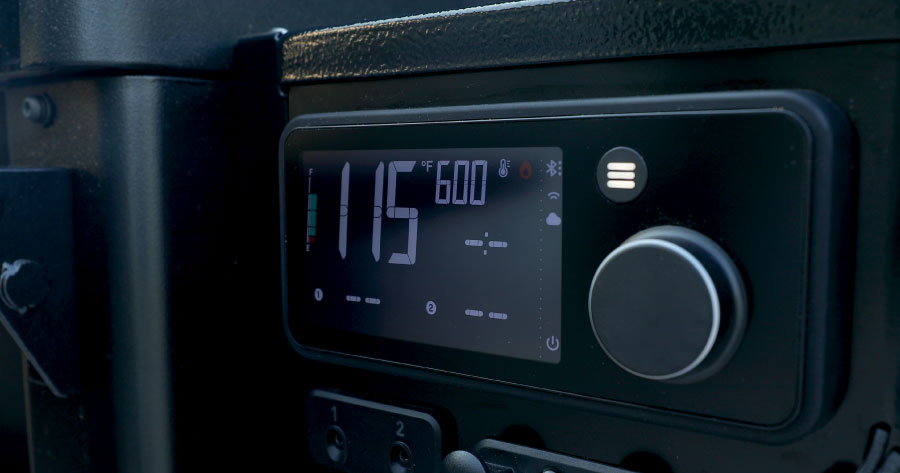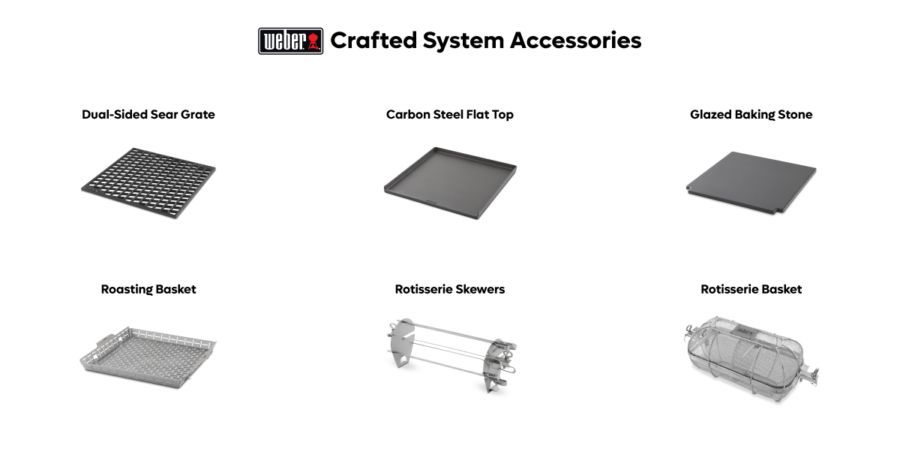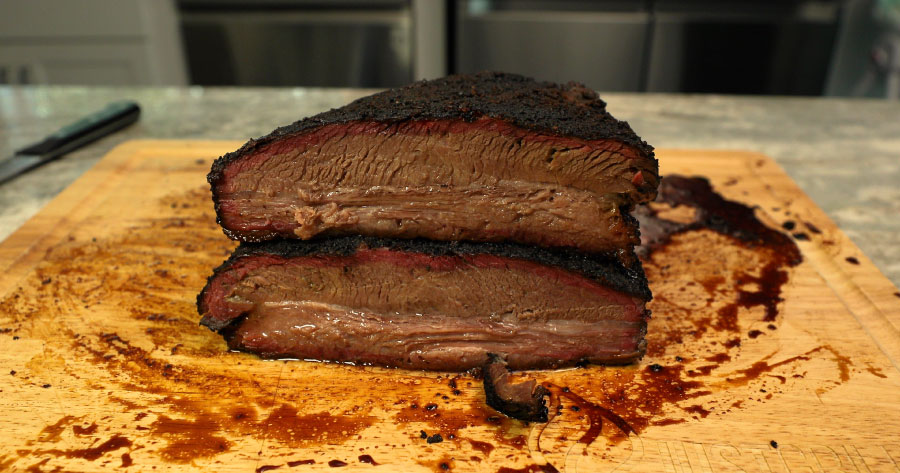Is The New Weber Searwood Pellet Grill Worth It?
There’s no doubt if you are shopping for a pellet grill in the sub $1,500 price category that the Weber Searwood 600 and Searwood XL 600 has come across your list of possible options. Both models have attractive price points and the grills are feature-laden. And there’s the fact that Weber, arguably the most iconic brand name in grilling, is the company creating these.
Our professional team has been testing this grill for months to see how well it performs and meets the advertised specifications. While much of the information in this post can be seen in the video above, this post does allow our team to expand further on certain thoughts in more detail.
You can also visit us in store to learn more about this grill in person, physically get your hands on one and talk with one of our experienced outdoor living specialists about these grills.
Weber Has You Covered
Pellet grills have the most moving parts between gas and charcoal grills. There is the auger, controller and motor that all work in sync to make a pellet grill run effectively. No matter how much you care for the things that you buy, the warranty does matter when buying a pellet grill. That’s not to say you’ll need to warranty a part. It’s more so that it should play a small factor in your decision whereas with some products it’s not as relevant as you might think.
Weber warranties the body of the grill for 5 years. That’s not industry-leading but is more than many other manufacturers offer. Weber warranties the electrical components, cooking grates, burn pot, heat diffuser, heat deflector and controller bezel for 3 years. This is considered great for the pellet grill industry.
Weber still has U.S.-based customer support that you can speak with a live person. They are one of the few companies in the grilling industry that still lets you contact them directly and speak with an actual representative should you need to.
The takeaway from this is that you are in good hands should you need to warranty a part and should feel comfortable. Weber, across all their products, have very generous warranties that provide great value in the products they offer.
Searwood Features
The Searwood models are billed as do-it-all grills. You can cook between 180° F to 600° F. This means you can bake, roast, smoke and grill with one unit. These grills are much different than traditional pellet grills in how they diffuse heat when smoking, roasting and baking.
Diffuser Plate

Weber uses a single heat diffuser shield that is basically a much larger version of their patented flavorizer bars. The shield doesn’t give full coverage across the entire cook surface but covers about 70% of the cooking surface. Weber designed the grill this way so you can cook at low temperatures or high temperatures without removing the diffuser. The grill is somewhat always ready to cook.
This is different from other pellet grills as most others use a solid heat diffuser plate (thickness varies) to cover the entire cooking surface. With those style diffusers you have to put the diffuser plate in to smoke and take it out to grill. That is if the pellet grill can get hot enough to actually grill. There are plenty of pellet smokers available in the market but not as many can be called pellet grills. With the Searwood diffuser style, it makes this process easier.
Rapid PID Controller

The Rapid PID Controller is advertised to get the grill to any temperature within 15 minutes of startup. Now, there is a caveat to this depending on the weather for those of you in cooler climates as that typically will prolong the startup due to colder temperatures.
The controller also will react quickly to major disruptions in temperature like when the lid is open allowing the grill to recover faster. The purpose of that is to keep the temperature as stable as can be throughout the entire cook. The more consistent and stable the temperature is, the better result your cook will be.
Weber Connect App
The Searwood uses the Weber Connect Smart Grilling Thermometer technology to operate the grill. The grill is WiFi and Bluetooth enabled. You can also connect and pair with the Weber Cloud to remotely control the grill (after starting it while present.)
Within the app you can follow along recipes step-by-step for great results. The directions are so detailed that they tell you when to flip, wrap, spritz and so much more.
Manual Mode (Lid Open Cooking)

Until the Weber Searwood, there is no such thing as open lid cooking with a pellet grill. Leaving the lid open on other pellet grills would pretty much derail a cook and lead to what is known as a ‘flame out’. A flame out happens when either the grill can’t keep pushing enough pellets for the flame to stay lit or it overcompensates and feeds too many pellets to the burn pot causing the flame to go out.
When the grill is set to manual mode, you are choosing between a general heat output from a 1-10 setting dial. Weber created this feature to complement the full-size griddle accessory allowing you to turn the pellet grill into a griddle. This feature can also be useful when you are a distracted griller. Let’s say you’re hosting a summer cookout and can’t pay attention to the grill fully while being in charge of the food. Using this setting will help protect your foods since cooking with the lid open, in general, takes longer than cooking with the closed.
Full Size Sear Zone


The Searwood is designed to be able to grill across the entire cooking surface. When you want to cook at 600° F you are able to use the entire main cooking surface for edge-to-edge grilling. You also have DirectFlame capabilities that allow the flame and drippings to help caramelize foods.
Smokeboost

The Smokeboost setting on the Searwood smolders pellets between 180° F and 200°F for enhanced smoky flavor. This setting can be deployed a few ways in varying lengths depending on what you’re cooking. The purpose of the setting adds more flavor to your food. You do not use this for the entire cook though.
Cleaning Management System


Weber makes the Searwood easy to cleanup. Ash and grease will funnel into two lower compartment drawers that make it easy to dispose of and keep the grill operating. The Searwood comes with a plastic scraper that you can use to push ash in the main cooking chamber to the drawer system below. At the bottom of the drawer system is a removable foil pan that can be dumped and replaced with a fresh pan.
Other Included Features
The Searwood models have a pellet changeout slot. If you want to change the flavor of pellets you can place a bucket or bin below the shoot and release the changeout to empty out the hopper. The hopper will hold a full 20 lbs of pellets. The XL 600 model has a fuel sensor to let you know when pellets are low.
One food probe is included with the grill. There are ports for up to two probes in total. The probe internal reading will display on the grills controller screen or you can monitor it in the Weber Connect App.
There are hooks on the backside of the main cooking chamber that allow you to hang the top cooking grate if it is not needed in the grill. The grill has two fixed legs and two fixed wheels. There is a side handle you can use to lift and wheel the grill around to move.
Upgrades for the Searwood
Furthering the notion of the Searwood being a do-it-all grill are the accessories you can purchases separately to do more with the grill. We touched on the Manual Mode that works with the Full-Size Griddle.
Weber also designed the Crafted Frame Kit to fit the Searwood so you can use that entire suite of accessories with the grill. The Crafted accessories include a flat top, roasting basket, sear grate, baking stone, wok/steamer and rotisserie crisping basket. Weber designed the Searwood to be compatible with a rotisserie too.

You can add a folding front shelf and a folding side shelf to the grill too.
How Does the Grill Perform?
When our professional team tests a grill and provides our opinion, we are factoring in a handful of measurables. Our team is gauging how the grill performs based on the advertised claims of the product, ease of use, how the grill stacks up to models from competitors in the industry, reliability of the product, cooking results from the unit and if the price point is warranted.
Heat Tests
Knowing how a grill will perform at different heat level settings is important. This helps you understand what you may need to adjust to to ensure a positive cooking results. Our team uses this tool, Fireboard 2 Pro, to test the ambient temperature at the grate level in all grills we test. Our team uses common tools that the average at-home griller has access to.
We test the grill on three heat settings: 225° F, 425° F and 600° F. This gives us a well-rounded idea of how the grill performs at three key temperature settings. We place the probes in multiple spots to understand the hot and cold spots of the grill. Our main test shows the probes left to right in the center of the grill. We also test each zone front to back using three probes with one in the center.


Starting with the 225° F readings, the grill got to temperature really quickly but it took about 15 minutes for it to level out and stabilize well. The grill read 228° F, 228° F and 225° F from left to right in the center above the diffuser plate. The back to front readings had a wider range. Starting on the left side, the back to front was: 245° F, 225° F and 245° F. The center read: 222° F, 226° F and 222° F. The right side read: 260° F, 222° F and 253° F. We also checked the top upper rack and that was anywhere from 222° F to 230° F.
When we raised the grill to 425° F, we tested the same zones with the exception of the top rack. The main left to right reading was 423° F, 421° F and 430° F. The left side back to front read: 510° F, 438° F and 480° F. The middle read: 413° F, 422° F and 423° F. The right side read: 496° F, 450° F and 488 ° F.
With the grill maxed out at 600° F, the left to right readings were: 570° F, 567° F and 593° F. The left side back to front read: 585° F, 576° F and 601° F. The center read: 583° F, 578° F and 610° F. The right side was 584° F, 583° Fand 614° F.
These numbers may seem a little off, especially the 425° F tests, but they are actually really good and we can explain. Throughout all of the tests the center temperature readings were pretty much spot on with the grills set temperature. This shows that food protected by the diffuser tends to have very even heat.
The higher temperatures we saw were on the back and front probes that were in places that the diffuser plate did not extend too. This meant more heat could rise in these spots. There are very few occasions where you are loading food to the brim in these grills that it would not be covered by the diffuser plate. And in those scenarios, you’re probably cooking burgers and other things that it’s okay if there are some hot and cold spots. Every grill will have hot and cold spots. There is no getting around that.
What we found is that this grills hot and cold spots are much less in size than other grills we’ve tested. The grill is able to get to all advertised temperatures and maintains its heat well.
Food Tests
Brisket
We smoked a brisket at 225° F for 24 hours on the Searwood. It was a choice brisket and weighed a little over 13 lbs before trimming. We wrapped the brisket in butcher paper around 156° F internally when it stalled. From there we let it go to 203° F internally before pulling and resting for two hours. We encountered no issues during this cook. The brisket has great flavor, a solid smoke ring and was juicy on in the inside.


Ribs
We smoked ribs at 275° F for two hours and then wrapped in butcher paper at 325° F for one more hour. We used two slabs of St. Louis Style ribs and one slab of Baby Back Ribs. The ribs were tender and cooked near perfect. They cleanly would pull from the bone with a normal bite but would stick to the bone otherwise. The smoke ring on each slab was prominent and the juiciness of each slab was noticeable.


Ribeye Steaks
There a re a multitude of ways to cook a steak on a pellet grill. For this test, we opted to run the grill at 600° F the entire time for the cook. The purpose of this was to test the searing capabilities of the grill. We grilled the steaks until 130° F internally and let them rest for five minutes. The steaks were cooked to medium doneness and had a decent crust and flavor.


App & Connectivity Tests
The grill pairs with your home WiFi network really easily. The setup was super simple by following the prompts in the app. Our team was able to test the Cloud capabilities by changing the grill temperature temporarily during the brisket cook while miles away from the grill.
The enhanced app experience with graphs and alerts makes this a user-friendly grill. We mentioned earlier the app is loaded with dozens of step-by-step recipe instructions that include photos and video. Our team has not experienced the WiFi or Bluetooth disconnecting from the grill.
Manual Mode
Our team has been using the full-size griddle accessory attachment with the Searwood set to Manual Mode. The performance of the grill has been solid without any issues noted by our team. The griddle maintains a good temperature throughout the cook and the grill has run smoothly. While our team did not weigh the pellets to see if this mode burns more pellets, our team notes that visibly it does not based on checking the hopper levels.
Overall Impressions of the Searwood
Factoring in everything we’ve covered and our teams knowledge in this industry, the Searwood 600 and Searwood Xl 600 gets the stamp of approval by our team. The grill is not complicated to use and showed solid performance. Our team has yet to have a bad cook after multiple months using this grill.
If you are local to the Tampa-St. Petersburg-Sarasota area, please come visit Just Grillin Outdoor Living today for help with your Searwood purchase. We stock both models with many of the popular accessories with these grills.
Just Grillin Outdoor Living is one of Weber’s top retailers in the entire country and for good reason. Come experience this in store today!
